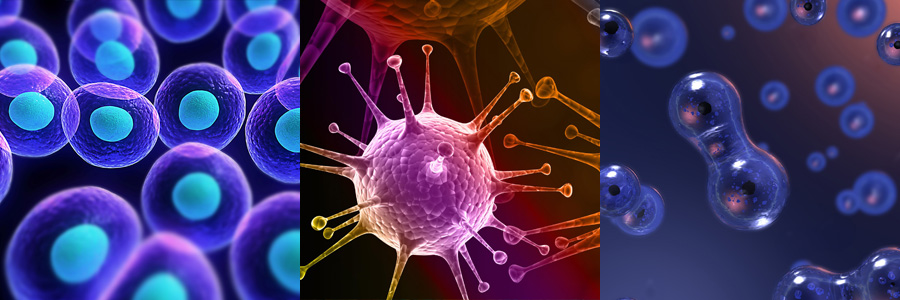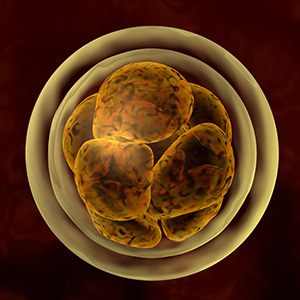Stem cells have the ability to develop — through a process called differentiation — into many different types of cells, such as skin cells, brain cells, lung cells and so on. Stem cells are a key component of regenerative medicine, as they open the door to new clinical applications. Regenerative medicine teams are studying a variety of stem cells, including adult and embryonic stem cells. Also being studied are various types of progenitor cells, such as those found in umbilical cord blood, and bioengineered cells called induced pluripotent stem cells. Each type has unique qualities, with some being more versatile than others.
Many of the regenerative therapies under development in the Center for Regenerative Medicine begin with the particular patient's own cells. For example, a patient's own skin cells may be collected, reprogrammed in a laboratory to give them certain characteristics, and delivered back to the patient to treat his or her disease.
In stem cell therapy, or regenerative medicine, researchers study how stem cells may be used to replace, repair, reprogram or renew your diseased cells. Stem cells are able to grow and develop into many different types of cells in your body. Stem cell therapy may use adult cells that have been genetically reprogrammed in the laboratory (induced pluripotent stem cells), your own adult stem cells that have been reprogrammed or cells developed from an embryo (embryonic stem cells). Researchers also study and test how reprogrammed stem cells may be turned into specialized cells that can repair or regenerate cells in your heart, blood, nerves and other parts of your body. These stem cells have the potential to treat many conditions. Stem cells also may be studied to understand how other conditions occur, to develop and test new medications, and for other research.

Stem cell therapy as a potential treatment for cardiovascular diseases, diabetes, degenerative joint conditions, brain and nervous system (neurological) conditions, such as Parkinson's disease, and many other conditions. For example, researchers are studying the possibility of using stem cell therapy to repair or regenerate injured heart tissue to treat many types of cardiovascular diseases, from adult acquired disorders to congenital diseases.
Cardiovascular diseases, neurological conditions and diabetes have been extensively studied in stem cell therapy research. They've been studied because the stem cells affected in these conditions have been the same cell types that have been generated in the laboratory from various types of stem cells. Thus, translating stem cell therapy to a potential treatment for people with these conditions may be a realistic goal for the future of transplant medicine and surgery. Researchers conduct ongoing studies in stem cell therapy. However, research and development of stem cell therapy is unpredictable and depends on many factors, including regulatory guidelines, funding sources and recent successes in stem cell therapy. Mayo Clinic researchers aim to expand research and development of stem cell therapy in the future, while keeping the safety of patients as their primary concern.
Cellular therapy is an umbrella term that comprises a number of different cell types. Adult cells, as the name suggests, are found in tissues or organs of adults and children. Embryonic cells are derived from embryos, usually donated for research purposes with informed consent of the donors. The topic of embryonic cells is a controversial one with many scientific, ethical, and political considerations. This report is focused solely on adult therapeutic cells and the potential they hold for regenerative medicine.
Autologous cells come from the person receiving the treatment.
Allogeneic cells come from another person.

Homologous cells come from the same tissue or organs to which they are being applied.
Non-homologous cells come from a different tissue or organ than those to which they are being applied. Autologous cells carry virtually no likelihood of being rejected by or attacking the host. Autologous cells may be the best choice in some conditions, but not others. For example, it is known that older cells may not be as effective as younger cells. Also, if autologous cells are causing the disease process or already harboring the disease susceptibility genes, allogeneic cells may better correct the disease process.
An example of autologous/homologous cellular therapy would be the application of cells extracted from the left elbow of a patient to the right elbow of that patient to treat lateral epicondylitis (tennis elbow).
An example of non-homologous/autologous cellular therapy would be the extraction of cells from adipose (fat) tissue for injection into the knee to promote cartilage restoration to address injury or age-related degeneration.
An example of allogeneic/homologous therapy is a bone marrow transplant from an unrelated donor to replace the bone marrow and blood of a patient with leukemia who is being treated with high dose chemotherapy.
An example of allogeneic/non-homologous therapy is injection of Mesenchymal stem cells or multi-potent stromal cells— both referred to as MSCs, derived from the bone marrow of one patient into another patient’s heart muscle in order to reduce inflammation, help protect the damaged heart tissue, and prevent scars from forming.